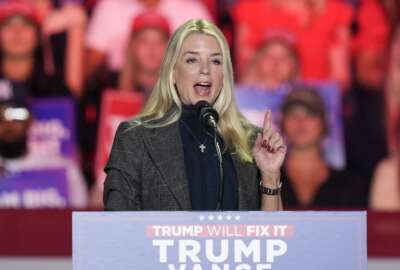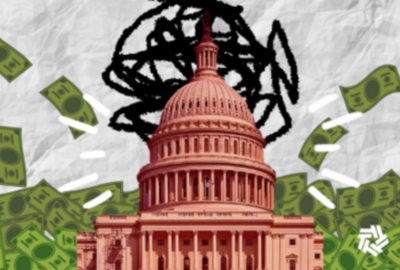Agency leaders ‘on a mission’ to pump up employee morale
Federal employees are growing increasingly frustrated with budget cuts, stagnant pay levels and a negative perception of the federal bureaucracy, government sur...
Federal employees are growing increasingly frustrated with budget cuts, stagnant pay levels and a negative perception of the federal bureaucracy, government surveys reveal.
Agency heads say they’re getting the message loud and clear.
“One of the terrible things that is occurring is this notion that the federal government doesn’t matter,” Commerce Secretary Penny Pritzker said at a townhall event hosted by the Partnership for Public Service as part of Public Service Recognition Week. “And it gets translated into people who work for the federal government don’t matter.”
Pritzker was joined by Homeland Security Secretary Jeh Johnson, Labor Secretary Tom Perez and Office of Personnel Management Director Katherine Archuleta to discuss how to improve employee morale.
“There are lot of people outside the Beltway — and inside the Beltway — who look on the federal government as a large bureaucracy that doesn’t really work for them,” Johnson said. “And that’s a perception that doesn’t comport with reality.”
Johnson, who’s led the agency for about six months, said he’s “on a mission” to turn around employee morale in DHS. In annual rankings of the “Best Places to Work in the Federal Government,” the agency has typically fared poorly, scoring last among large agencies.
Among the top of his morale-boosting priorities is working to fill leadership vacancies that once dotted the department. Since Johnson was confirmed in December, the Senate has approved six additional high-level positions at the agency.
“I think good leadership starts with finding other good leaders. … We’re injecting a new energy in the department,” he said.
In addition, he’s promoting “greater transparency” in promotion, training and mentoring opportunities, he said.
“We’re bringing back the various awards programs within DHS,” Johnson said. The purpose of the awards isn’t always monetary.
“I think thanking people for a job well done is good,” he said. “I believe in constructive criticism and feedback, but thanking someone for a job well done is critical.
DOL also relaunched its employee-recognition awards, which had been “mothballed for years,” Perez said. New this year is an “innovation award,” to reward forward-thinking employees.
“We don’t have this largesse to say ‘thank you’ in the form of a raise and things of that nature,” Perez said. “But there are other things you can do to send a very unmistakable message that ‘Your input matters and as a result of your ingenuity, we’re getting better.'”
Feds struggle under budget woes
But there’s a limit to what secretaries can do on their own, they said.
“There are certain life-pay issues that I can’t solve alone,” Johnson said. “I need the Congress to help me with that, obviously.”
Federal workers received a slight 1 percent uptick in across-the-board pay levels in January after a three-year pay freeze. President Barack Obama has requested another 1 percent pay raise for next year as well.
In addition, federal agencies have been forced to tighten the purse strings in recent years. Last year, across-the-board sequestration cuts left many agencies stretched thin and understaffed.
“Austerity has consequences,” Perez said. “This is the first economic recovery that I’m aware of … in which government hiring has actually gone down,” he said. “If we had just stayed flat, we’d have 600,000 more people in the workplace.”
The two-week government shutdown last fall only added insult to injury.
“It’s not sustainable to ask folks to continue to work in an environment where you don’t give them the resources to do their job and you tell them, ‘I’m sorry, please go away for two weeks and we may or may not pay you,'” Pritzker said. “That’s just not tenable, it’s not supportable and … we cannot accept that as business as usual.”
“Tell us we have less budget — that’s fine,” she added. “Then let us manage to that.” But the government shutdown and budget showdowns are “very challenging and disrespectful to the people who work for us.”
But even with frustration over pay raises and dwindling budgets, federal employees remain committed to their jobs, Archuleta said. In fact, according to OPM’s annual Employee Viewpoint Survey, the scores measuring how engaged federal employees are in their work have generally held steady. More than 95 percent of respondents to the survey said they were willing to put in extra effort to get the job done and another 90 percent said they felt the work they do is important.
“I just want to be sure as we talk about the morale of federal employees, I don’t want that to be confused with how engaged federal employees are,” Archuleta said. “We have given them some very, very difficult situations. We’ve taken away some of the resources they need to get the job done, because we, as managers, have to make hard decisions. But every day they show up. And every day they’re dedicated to what they’re doing.”
Workforce in flux
Just 7 percent of the overall workforce is under the age of 30, according to OPM statistics, compared to 23 percent of the broader labor force. Meanwhile, about 30 percent of current employees will be eligible to retire in 2017, the Government Accountability Office says.
“The need for younger workers in our workforce is one obviously that we’re all focused in on,” Archuleta said. Agencies recruitment strategies need to be tuned up with more of a focus toward young, technologically savvy applicants, she said.
“We’ve got to go to where they are and communicate with them how they communicate,” she said. “Frankly, the system for recruiting young people today is really designed for people like me — and I’m not young anymore. I’ve got to figure out how to use social media to capture the attention of young people today. … I’ve got to convey a message in 20 seconds.”
But grabbing younger applicants’ attention is only half the battle, she said. Archuleta said she wants to make sure the entire hiring process is streamlined and simplified.
“We’re going to try to take the USAJobs website into the new century and really make sure that it doesn’t take 90 minutes — at least at the first blush — to get through it.”
As the federal workforce ages, there are also gaps opening up in the ranks of mid-level managers and senior executives, Archuleta said.
Pritzker, who joined Commerce after a long and successful career in the private-sector and philanthropy, said part of the problem is that government career paths are not always clear.
“It’s my observation that we’re pretty good at recruiting and getting folks to stay with us till they’re about in their mid-30s,” she said. Then, as they start building families, many seek out higher-paying jobs in the private sector.
“We make it way too difficult for them to come back,” she said. “I mean, our rules, our processes are just too cumbersome.”
RELATED STORIES:
Hearing weighs causes of, solutions to low morale in federal workforce
Size of civilian federal workforce increases, but more feds eligible to retire
Pay freeze, sequestration take bite out of employee satisfaction, OPM survey reveals
Copyright © 2024 Federal News Network. All rights reserved. This website is not intended for users located within the European Economic Area.





